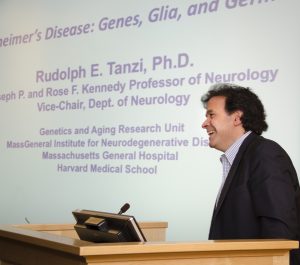Dr. Rudolph Tanzi is a Professor of Neurology at Harvard Medical School and and the Director of the Genetics and Aging Research Unit at Massachusetts General Hospital (MGH). He co-discovered three of the first Alzheimer’s disease genes and has identified several others in the Alzheimer’s Genome Project, which he directs. Dr. Tanzi was the keynote speaker of the 2017 Gordon Science Symposium and its annual David Elmaleh Lecture. Below is the summary of his inaugural address titled “Alzheimer’s disease: a story of genes, glia, and germs”.

Alzheimer’s disease (AD) is the most common form of dementia affecting the elderly and is characterized by global cognitive decline. AD is strongly influenced by both genetic factors and lifestyle. While certain rare gene mutations, e.g. in the APP, PSEN1 and PSEN2 genes guarantee onset of AD before 60 years old, most cases of AD (>97%) involve genetic susceptibility factors, e.g. APOE, and lifestyle, e.g. diet, exercise, sleep, intellectual and social engagement, stress levels, and brain trauma. Most recently we have found that low-grade infections, e.g. bacterial, fungal, viral, in the brain may also play a role by rapidly nucleating beta-amyloid deposition as an antimicrobial protection response of the brain’s innate immune system. Genetic susceptibility factors have been elucidated over the past decade using genome-wide association studies (GWAS) and more recently by follow up with whole genome sequencing (WGS) and whole exome sequencing (WES). We are now carrying out GWAS using approximately 50 million single nucleotide variants (SNV) from WGS and WES (whole genome sequencing association studies; WGSAS). As AD-linked/associated functional SNVs are identified in these studies, they are being tested in our 3D human stem cell-derived neural culture models of AD, in which we have shown beta-amyloid directly drives tangle formation. Many of the more recently identified AD genes are involved in innate immunity, e.g. CD33, which we first reported in our family-based GWAS in 2008 (along with ADAM10 and ATXN1). To study CD33 and other innate immune-related AD genes, we have incorporated microglia into our 3D neural cultures while also utilizing classic transgenic mouse models.

